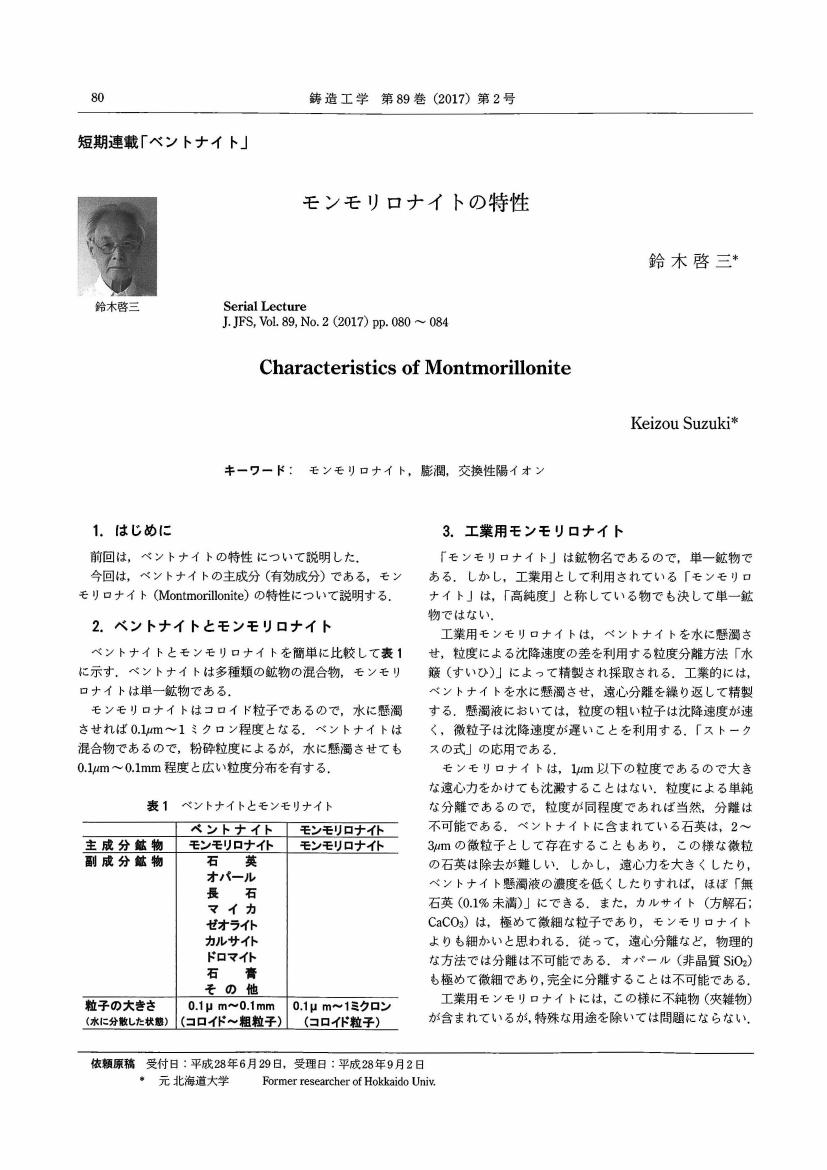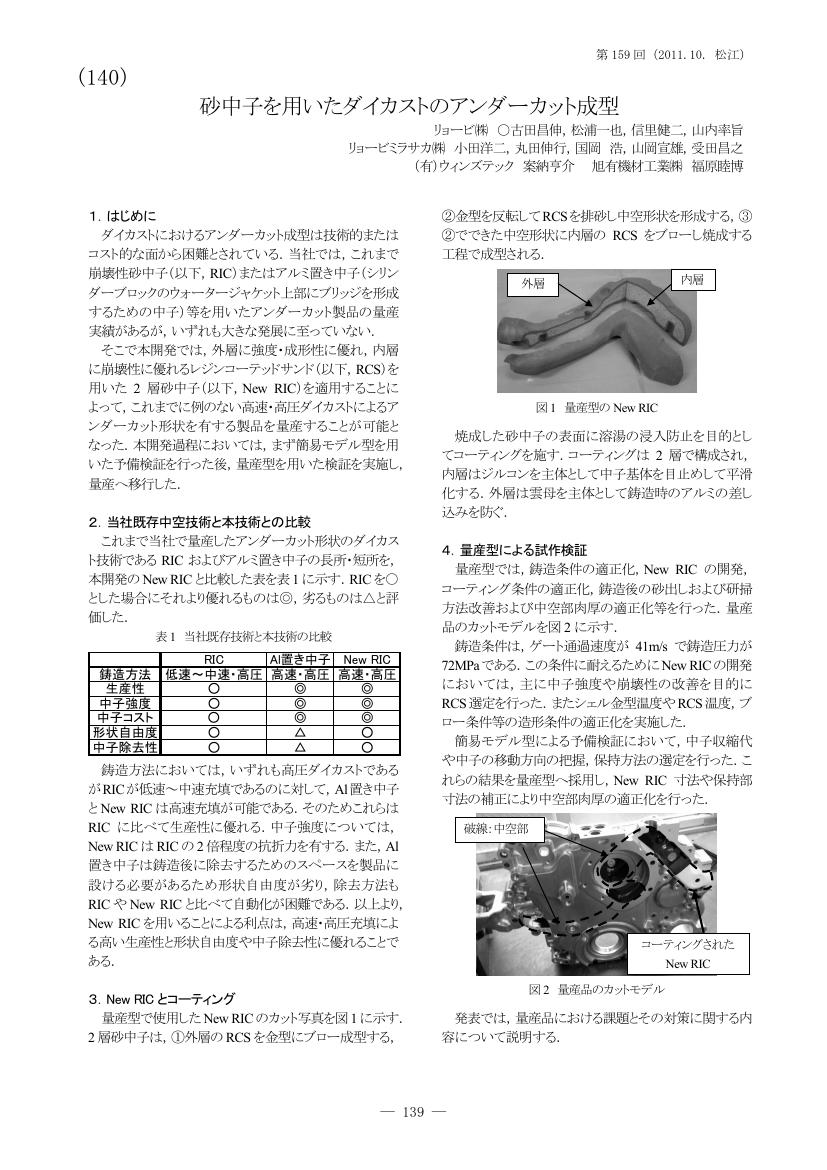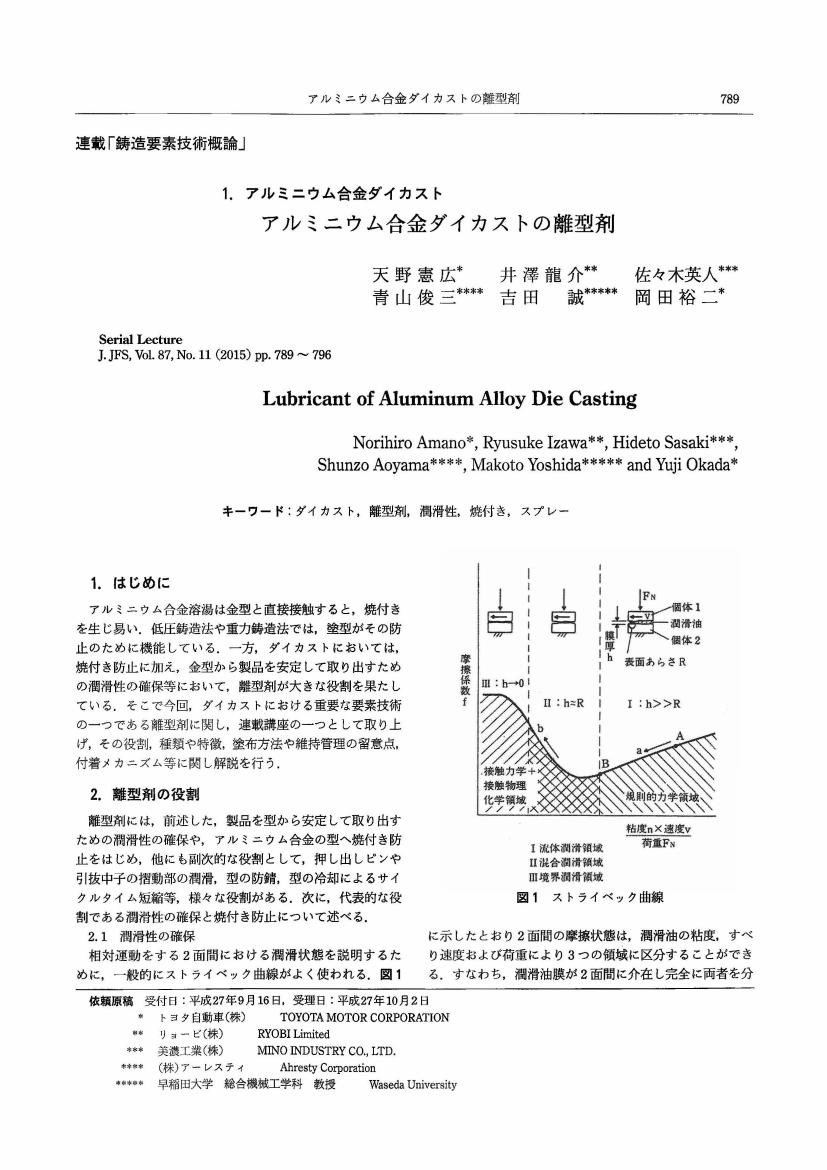1 0 0 0 OA 鋳鉄の凝固過程の研究 —共晶集団について—
- 著者
- 大平 五郎 井川 克也
- 出版者
- 公益社団法人 日本鋳造工学会
- 雑誌
- 鋳物 (ISSN:00214396)
- 巻号頁・発行日
- vol.28, no.6, pp.403-409, 1956-06-25 (Released:2012-11-09)
- 参考文献数
- 8
- 被引用文献数
- 5
The eutectic of cast iron forms with a spheroidal crystallization front. The pattern, the number and the size of these eutectic cells vary with the amount of primary austenite and a small amount of so-called third elements, i. e. oxygen, sulphur, manganese and calcium-silicide. The results obtained are as follows : i) The number of eutectic cells of pure Fe-C alloy increases with carbon content up to 4.11% C and decreases at higher carbon contents. The former eutectic cells contain flaky graphite and the latter eutctic graphite. ii) Small amount of oxygen and sulphur decreases the number of eutectic cells of oxygen in cast iron and converts flaky graphite into eutectic. iii) The inoculation of calcium silicide to the cast iron melts containing oxygen or sulplur increases the number of eutectic cells and converts eutectic graphite into flaky. iv) The addition of manganese to the cast iron containing sulphur can not completely convert eutectic graphite to flaky. v) The types of manganese sulphide vary with the ratio Mn/S from massive angular type to elongated anchor type according to the decrease of the ratio. vi) The inoculation of calcium silicide to the cast iron containing sulphur and manganese produces the small granuler type of manganese sulphide.
1 0 0 0 OA インドネシアにおける高錫青銅の鍛造と組織変化
- 著者
- 中川 一人 塩川 博義 竹島 正博 木下 哲人
- 出版者
- 公益社団法人 日本鋳造工学会
- 雑誌
- 鋳造工学 全国講演大会講演概要集 第181回全国講演大会講演概要集 (ISSN:18805388)
- 巻号頁・発行日
- pp.118, 2023 (Released:2023-06-17)
1 0 0 0 OA 鋳造シミュレーションソフトTopCAST
- 著者
- 安藤 彰祐 羽座 健二
- 出版者
- 公益社団法人 日本鋳造工学会
- 雑誌
- 鋳造工学 (ISSN:13420429)
- 巻号頁・発行日
- vol.86, no.12, pp.946-950, 2014-12-25 (Released:2019-01-01)
- 参考文献数
- 8
- 被引用文献数
- 1
1 0 0 0 OA モンモリロナイトの特性
- 著者
- 鈴木 啓三
- 出版者
- 公益社団法人 日本鋳造工学会
- 雑誌
- 鋳造工学 (ISSN:13420429)
- 巻号頁・発行日
- vol.89, no.2, pp.80-84, 2017-02-25 (Released:2022-01-01)
- 参考文献数
- 9
1 0 0 0 OA 砂中子を用いたダイカストのアンダーカット成型
- 著者
- 古田 昌伸 松浦 一也 信里 健二 山内 率旨 小田 洋二 丸田 伸行 国岡 浩 山岡 宣雄 受田 昌之 案納 亨介 福原 睦博
- 出版者
- 公益社団法人 日本鋳造工学会
- 雑誌
- 鋳造工学 全国講演大会講演概要集 第159回全国講演大会講演概要集 (ISSN:18805388)
- 巻号頁・発行日
- pp.139, 2011 (Released:2017-03-01)
1 0 0 0 OA 幕末の鋳物の大砲
- 著者
- 中野 俊雄
- 出版者
- 公益社団法人 日本鋳造工学会
- 雑誌
- 鋳造工学 (ISSN:13420429)
- 巻号頁・発行日
- vol.72, no.2, pp.117-122, 2000-02-25 (Released:2014-12-18)
- 参考文献数
- 23
- 被引用文献数
- 2
1 0 0 0 OA NC切削加工による高速鋳型作製技術
- 著者
- 岩田 靖 岩堀 弘昭 内藤 国雄 大庫 和孝
- 出版者
- 公益社団法人 日本鋳造工学会
- 雑誌
- 鋳造工学 (ISSN:13420429)
- 巻号頁・発行日
- vol.75, no.12, pp.870-874, 2003-12-25 (Released:2015-01-07)
- 参考文献数
- 3
A sand block was developed for direct machining with a numerical contorol machine. The sand block has a cutting resistance of 30N which is as small as 1/300 that of steel block. Especially, sand blocks made of fine spherical particles have better dischargeability and dimensional accuracy, thus providing excellent machinability. Direct machining of a sand block reduces molding time. For example, it takes merely four hours to complete the mold for the cylinder head cover of an automobile engine.
1 0 0 0 OA 日本におけるダイカストの歴史
- 著者
- 西 直美
- 出版者
- 公益社団法人 日本鋳造工学会
- 雑誌
- 鋳造工学 (ISSN:13420429)
- 巻号頁・発行日
- vol.78, no.4, pp.199-206, 2006-04-25 (Released:2015-01-10)
- 参考文献数
- 12
- 被引用文献数
- 1
1 0 0 0 OA 新材料と先駆者たち
- 著者
- 木村 康夫
- 出版者
- 公益社団法人 日本鋳造工学会
- 雑誌
- 鋳造工学 (ISSN:13420429)
- 巻号頁・発行日
- vol.69, no.11, pp.947-950, 1997-11-25 (Released:2014-12-18)
- 参考文献数
- 19
- 被引用文献数
- 1
1 0 0 0 OA 高島秋帆の徳丸原洋式調練と軍制改革
- 著者
- 小西 雅徳
- 出版者
- 公益社団法人 日本鋳造工学会
- 雑誌
- 鋳造工学 全国講演大会講演概要集 第146回全国講演大会講演概要集 (ISSN:18805388)
- 巻号頁・発行日
- pp.19-20, 2005 (Released:2017-12-01)
- 参考文献数
- 3
1 0 0 0 OA 通常ダイカスト法によるアルミクローズドデッキシリンダブロックの実用化
- 著者
- 高橋 忠生 多胡 博司 萬谷 信廣
- 出版者
- 公益社団法人 日本鋳造工学会
- 雑誌
- 鋳物 (ISSN:00214396)
- 巻号頁・発行日
- vol.66, no.5, pp.371-375, 1994-05-25 (Released:2015-01-21)
- 著者
- 吉井 武輝 古田 将吾 小林 正和 三浦 博己
- 出版者
- 公益社団法人 日本鋳造工学会
- 雑誌
- 鋳造工学 (ISSN:13420429)
- 巻号頁・発行日
- vol.93, no.10, pp.604-611, 2021-10-25 (Released:2021-11-01)
- 参考文献数
- 10
Image-based finite element (FE) simulation, based on images of a model built with 3D images obtained by synchrotron radiation nano-tomography, was performed to investigate the point of preferential damage on Si particles in the early stage of tensile deformation in Al-10%Si casting alloys. By reproducing stress concentration on Si particles with the FE simulation, the effects of particle parameters such as (1) particle size, (2) particle orientation to loading direction, and (3) particle shape on damage were evaluated. Nano-tomography observation suggested that the parameters influence damage. The increasing rate of maximum hydrostatic stress differed depending on the Si particle size. Larger particles showed rapid increment in stress, suggesting that preferential damage may occur in large particles at an early stage of tensile deformation. In the study on the influence of particle orientation, particles whose longitudinal direction are more or less parallel to the tensile direction tend to also show rapid increment in stress. However, the most rapid development of the maximum hydrostatic stress was observed in particles possessing small Gaussian curvature which corresponds to severe necking. Comparisons of particles having specific parameters with damaging behavior revealed that the most influential parameter of particles on stress concentration was particle shape possessing necking.
1 0 0 0 OA 球状黒鉛鋳鉄における接種の役割
- 著者
- 鹿毛 秀彦
- 出版者
- 公益社団法人 日本鋳造工学会
- 雑誌
- 鋳造工学 (ISSN:13420429)
- 巻号頁・発行日
- vol.74, no.9, pp.601-604, 2002-09-25 (Released:2015-01-07)
- 参考文献数
- 2
1 0 0 0 OA ねずみ鋳鉄の枯らし処理過程における内部組織構造の変遷挙動
- 著者
- 鶴尾 大介 望月 栄治 岸 陽一 矢島 善次郎
- 出版者
- 公益社団法人 日本鋳造工学会
- 雑誌
- 鋳造工学 全国講演大会講演概要集 第152回全国講演大会講演概要集 (ISSN:18805388)
- 巻号頁・発行日
- pp.105, 2008 (Released:2017-03-01)
1 0 0 0 OA アルミニウム合金ダイカストの離型剤
- 著者
- 天野 憲広 井澤 龍介 佐々木 英人 青山 俊三 吉田 誠 岡田 裕二
- 出版者
- 公益社団法人 日本鋳造工学会
- 雑誌
- 鋳造工学 (ISSN:13420429)
- 巻号頁・発行日
- vol.87, no.11, pp.789-796, 2015-11-25 (Released:2020-01-01)
- 参考文献数
- 11
1 0 0 0 OA 二輪車設計から見たダイカスト技術の課題
- 著者
- 山縣 裕
- 出版者
- 公益社団法人 日本鋳造工学会
- 雑誌
- 鋳造工学 (ISSN:13420429)
- 巻号頁・発行日
- vol.79, no.5, pp.251-258, 2007-05-25 (Released:2015-01-13)
- 参考文献数
- 28
- 被引用文献数
- 1
1 0 0 0 アルミニウム合金溶体化処理に流動層炉を利用するための基礎的検討
- 著者
- 水谷 京平 戸田 裕之 綿貫 雅敏 杉浦 協司 竹下 裕市
- 出版者
- 公益社団法人 日本鋳造工学会
- 雑誌
- 鋳造工学 全国講演大会講演概要集
- 巻号頁・発行日
- vol.162, pp.96-96, 2013
- 著者
- 小林 正和 杉浦 協司 竹下 裕市 戸田 裕之
- 出版者
- 公益社団法人 日本鋳造工学会
- 雑誌
- 鋳造工学 (ISSN:13420429)
- 巻号頁・発行日
- vol.86, no.3, pp.209-215, 2014
<p> The feasibility of applying the fluidized bed furnace to the solution and aging treatments of aluminum alloys was assessed by examining concerns such as the efficiency of heat treatments and delay of quenching, together with its merits such as the shortening of heat treatment and the possibility of high temperature heat treatments.</p><p> It was concluded that this method realizes high efficiency of heat treatments, which is comparable to that attainable with the combination of a salt bath and oil bath. By suppressing the delay time within 20 to 30sec. after the removal of works from the fluidized bed furnace, no degradation in mechanical properties occurs. The allowable delay time is dependent on the work size. The solution treatment time can be shortened to 60min. or below. Good mechanical properties were obtained even with a short solution treatment time of 15min. depending on the size and thickness of the work. This also enables suppression of pore growth at the same time. In addition, high temperature heat treatment at around ternary eutectic temperatures was realized by precise temperature control, thereby realizing superior mechanical properties and shorter heat treatment time.</p>
1 0 0 0 鑄物砂の燒付現象について
- 著者
- 山本 忠次
- 出版者
- 公益社団法人 日本鋳造工学会
- 雑誌
- 鋳物 (ISSN:00214396)
- 巻号頁・発行日
- vol.26, no.2, pp.84-94, 1954
By investigating the sand adhering phenomena on the foundry products and the laboratory specimens, the chief causes were analysed and therefrom the factors of its prevention were determined. </br> “Burn-on”, the phenomenon which is generally called for “Hard adherence of sand or core”, in Japanese foundries can be cl ssif ed into two types; one is the adhesion of fused and sintered sand on the casting surface, and the other is caused by the penetration of metal into the mould surface. The adhesion phenomena mostly found in foundries belong to the latter type, which was chiefly investigated in this work. </br> Macroscopic and microscopic examinations show that the slag formation between cast metal and the mould surface is an effective factor of preventing penetration, provided that the casting temperature, the solidifying time, the static pressure of metal, etc., are not extremely severe. </br> The oxidation of the interface between the metal surface and the mould is violent, and the penetrated metals are much decarbonized. Some examples of selective oxidation of Mn and Fe are listed-up by analysing the slag layer. </br> For the static pressure of molten metal, the result of the laboratory test and calculation show that the metal penetration is very remarkable when the blacking, slag formation and the back pressure do not exist. </br> From the thermochemical point of veiw concerning the process of penetration, it is concluded that the fundamental natures of moulding sand, that is, the high purity, good refractoriness and the round shape are the most important factors of preventing penetration. </br> In addition, required factors of preventing penetration in the foundry practice are summarized.
- 著者
- 田辺 郁 茂木 徹一 マリア エレナ ロベルト
- 出版者
- 公益社団法人 日本鋳造工学会
- 雑誌
- 鋳造工学 (ISSN:13420429)
- 巻号頁・発行日
- vol.75, no.7, pp.474-478, 2003
In order to demonstrate the superiority of granular grain structure for thixocasting materials, semisolid samples with granular and dendrite structures were cast into a permanent mold by a punch. The test piece consisting of granular crystals revealed that the punch power was less than 1 kN until three quarters of the casting process. In contrast, the structure consisting of dendrite crystals revealed that the punch power was greater than 8 kN until one quarter of the casting process, and the power increased as the casting process proceeded. Granular grains of primary α aluminum surrounded by liquid phase could be easily moved into the die cavity, since the liquid phase acted as a lubricant. However, with test piece consisting of dendrite crystals, the liquid phase only moved at the first stage and the deformation resistance increased.












